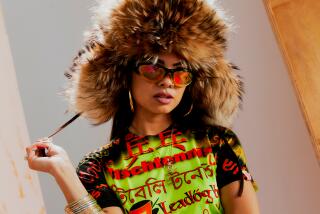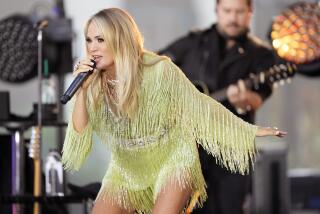Fashion 88 : Queen of Hats : Patricia Underwood Is Milliner to the Flamboyant, but She’s as Understated as Her Classic Chapeaus
Princess Diana’s matched-up dressing is almost too princessy, and the hats of Sarah, Duchess of York, are atrocious, if you ask Patricia Underwood. But she doesn’t critique the royal fashion just to be mean. Underwood is considered royalty herself, in a manner of speaking. She’s the queen of hats. The slightly eccentric, near-famous British designer has done as much as any woman in America to bring custom-quality head wear to the States.
In her tiny factory on New York’s West 40th Street, she and a scant seven assistants hand-finish not more than 100 hats in any week and ship them to stores across the United States, as well as several in Europe. It’s a short list of just more than 50 shops, but it’s the A-list.
In London she sells to Browns and Harvey Nichols, in New York to Bergdorf Goodman, in Los Angeles to Neiman-Marcus, Bullocks Wilshire and Ecru on Melrose Avenue.
Despite the heady price tags (fur trims range as high as $700 this fall, everyday felts are priced from $175 to $400), she can hardly keep up with the demand. Bergdorf recently ordered 500, sold them all, and reordered almost as many again.
While Underwood isn’t one to drop names of the rich and famous who wear her label, with effort you can pry a few loose. Princess Caroline of Monaco and New York socialite Evangeline Bruce are among them.
In Hollywood, Cher recently swept up half a dozen sou’wester straws at once. Linda Kozlowski wore them in her two “Crocodile Dundee” movies. Molly Ringwald, Diana Ross and the Pointer Sisters all have an Underwood in their closets. But the Hollywood hat wearer she admires most is the “gutsy, tenacious” Joan Collins--whom she once saw wearing an Underwood beret on “Dynasty.”
Despite her flamboyant client list, Underwood’s classical hats are almost painfully pure of line. She made her name on that feature, and a near-Puritan restraint from adornment.
Neutral colors, especially black, gray and taupe, still appear to be her favorites. The hat she personally wears this fall is a black leather gaucho from her new collection.
But as a concession to a growing demand for decoration, she started adding trims to some of her brims--grosgrain bows, bands of mink or bunches of fabric berries. And she’s expanded her color chart. This fall there are tangerine and lime Underwoods for sale, which she says do especially well in Los Angeles.
Somehow, despite their conservatism, she always manages to work something else into her felts and fur trims. They’re just a bit overdrawn and it gives them a playfulness that helps explain why top New York designers, including Bill Blass and Patricia Pastor for Perry Ellis, phone Underwood whenever they need hats to accessorize fashion shows.
For fall, Blass chose a top hat and Pastor went with a big, black roll brim, the sort of thing a swashbuckling pirate would wear.
Whatever else her followers own, they all have at least one version ofthe Underwood trademark hat. She’s repeated it often during her 15 yearsin business and refers to it as “the large bonnet.” It’s a felt hat whose roll brim is extra deep and wide.
“You look like the Queen Mother in it,” she said, pointing out a ruby version trimmed in dyed-to-match mink whose $600 price tag is fit for a queen. “Women like it with the fur trim, it’s very romantic.”
To look at her you wouldn’t know Underwood was such a big shot. She wears her classic English features unadorned, and her taste is understated. Usually, she dresses in black, but lately she’s been adding color--amethyst pumps and sweater with banker’s-gray trousers on one recent afternoon. The outfit seems conservative enough; however, when a photographer started snapping her picture, she unexpectedly slipped the sweater off one shoulder.
When she comes to Los Angeles, women stop her in stores and ask for her opinion. “I drive a red convertible,” said one blond-haired woman as she fidgeted with her huge eyeglasses. “Should I get the beret or the one with the brim?”
Lost the Sale
Watching her answer, you would wonder how she ever sold one hat. She was careful not to dictate to the woman, pointed out the advantages to both styles, seemed to lean toward one and then the other, and ended by losing the sale.
Selling isn’t her strong point. She wins hearts just by wearing her hats all the time--”as an object lesson”--and by her obvious knowledge of the field. She’s a bit of a stickler about it, but it only shows when she describes how she evaluates a hat.
“I look at the stitching, there should be a double row around the brim. And the quality of the ribbon inside the hat is important, and whether or not there’s a wire in the brim.”
She learned to ask such questions at the Fashion Institute of Art and Technology in New York after she relocated there from London and married her first husband, an American.
She says she set up her factory on a shoestring budget and supposes that is why so many people have done the same now that hats are so popular.
Very Good Ratio
“I am the chairman of my own company, but I’m not a multimillion-dollar business,” Underwood said during a recent visit to Neiman-Marcus in Beverly Hills. “Still, on a percentage basis, my ratio is very good.”
This season she is adding waterproof, knitwear and velvet styles to her collection, priced from $20 to $125.
“There were requests that I make something less expensive,” she explained. With business so brisk, the only worry she mentions is an unusual one. “A hair revolution could have an effect,” she says quietly.
Bouffant, lacquered looks of the ‘60s didn’t help the hat industry. And the big, big hair styles of the early ‘80s left little room for anything on top either. Hat-hair is simply styled and worn close to the head, Underwood explains.






